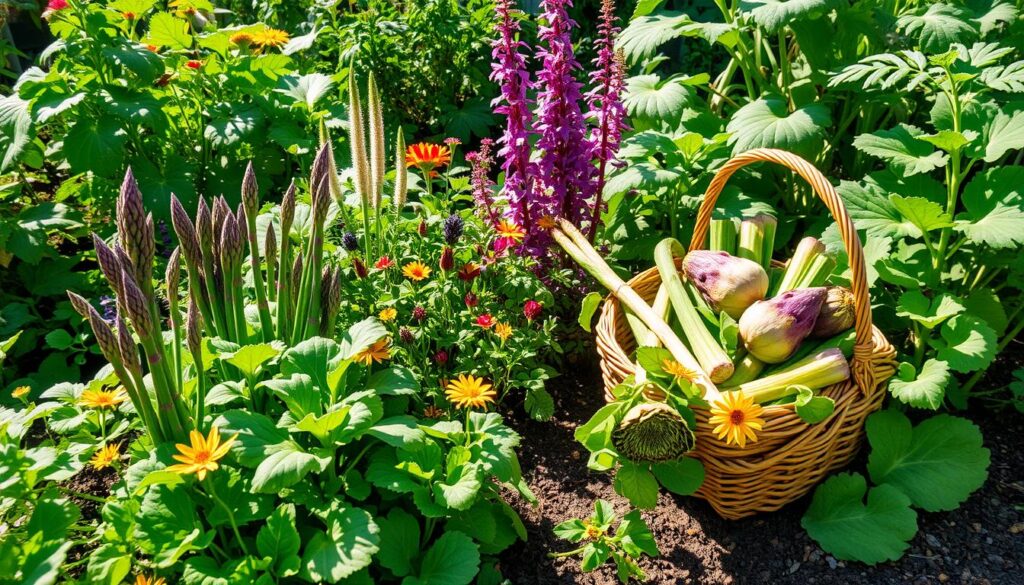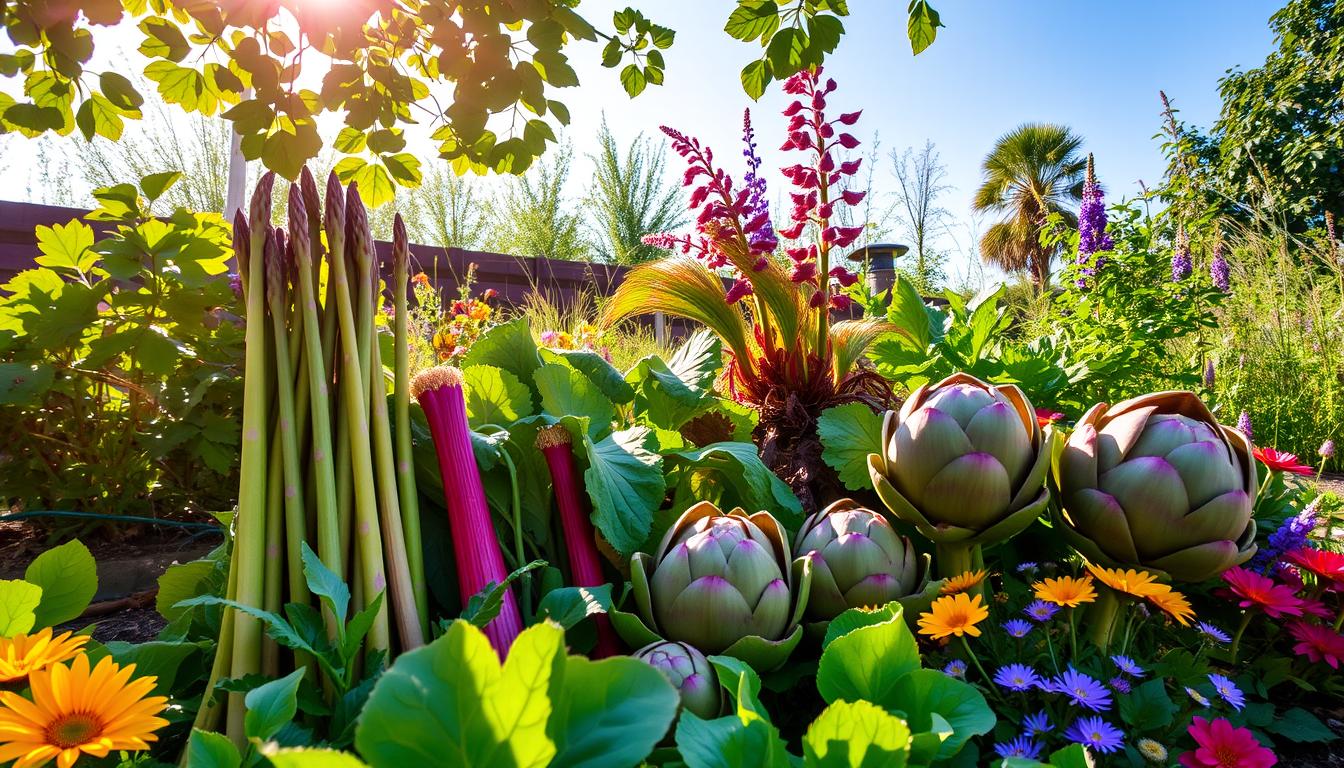I love gardening and have found that growing perennial vegetables is amazing. These plants keep giving us food all year. They are great for getting fresh, healthy food without much work.
In this guide, I’ll teach you how to grow a great perennial vegetable garden. You’ll learn about picking the best plants for your area, getting your soil ready, and taking care of your garden. You’ll also find out how to keep pests away without using harmful chemicals. By the end, you’ll know how to have a garden full of fresh veggies all year.

Key Takeaways
- Perennial vegetables offer continuous harvests for a sustainable garden
- Learn how to choose the right perennial varieties for your local climate
- Discover soil preparation and planting techniques for a thriving perennial veggie garden
- Manage pests and diseases organically to maintain the health of your perennial crops
- Incorporate perennial veggies into your garden design for a beautiful and productive landscape
Understanding Perennial Vegetables
Perennial vegetables are a treasure in gardening. They live for more than two years, giving a steady harvest with little work. By learning about perennial vegetables and their benefits, gardeners can grow food easily and sustainably.
Defining Perennial Vegetables
Perennial vegetables are plants that grow year after year without replanting. They have strong roots and leaves that last through many seasons. This makes them a reliable food source. Popular ones include asparagus, Jerusalem artichoke, and choko.
Benefits of Perennial Veggies
- Less work needed: Perennial vegetables save time and effort by not needing to be replanted every year.
- More food: They often produce more than annual crops, giving gardeners a better return on their investment.
- Good for the environment: They help keep the soil healthy and prevent erosion, reducing the need for new land.
The advantages of perennial vegetables are many. They make any garden more sustainable and enjoyable. Exploring these benefits can encourage gardeners to grow a variety of perennial veggies.
“Perennial vegetables are the unsung heroes of the gardening world, offering a wealth of benefits that go beyond the traditional annual crops.”
Choosing the Right Perennial Veggies
Choosing the right perennial vegetables is key for a great garden. There are many options, from cool-climate favorites to heat-loving varieties. Each one fits different growing conditions.
Perennial Veggie Varieties for Your Climate
It’s important to pick the best perennial vegetables for your area. Here are some top picks:
- For cooler climates: Rhubarb, asparagus, and Jerusalem artichokes do well in cold winters and mild summers.
- For warm, Mediterranean-style climates: Artichokes, Turkish rocket, and Egyptian onions love hot, dry summers.
- For hot, humid regions: Malabar spinach, Okinawa spinach, and perennial kale are perfect for tropical and subtropical areas.
Choosing the right perennial vegetables for your climate ensures a bountiful harvest every year.
| Perennial Vegetable | Best Suited Climates | Key Features |
|---|---|---|
| Rhubarb | Cool, temperate regions | Thrives in cold winters, produces large, edible stalks |
| Artichoke | Mediterranean, warm climates | Produces large, flavorful flower buds, requires hot, dry summers |
| Malabar Spinach | Tropical, subtropical regions | Heat-loving, easily grows in hot, humid conditions |
By choosing the right perennial vegetables, you can have a diverse and thriving garden. It will provide a continuous harvest all year round.
How to Grow Perennial Vegetables for Continuous Harvests
Growing perennial vegetables is a great way to have fresh produce all year. By knowing how to grow these hardy plants, you can have a garden that keeps giving. You’ll get plenty of food every season.
Planting them right is key. Most veggies like asparagus and rhubarb need to be planted 6-12 inches deep. Space them 2-3 feet apart. This helps their roots grow strong, so they can handle the seasons and keep giving.
It’s also important to keep the soil moist but not too wet. These plants like soil that’s rich in nutrients and holds some water. Using a drip irrigation system or mulch can help keep the soil just right.
| Perennial Vegetable | Planting Depth | Spacing | Moisture Needs |
|---|---|---|---|
| Asparagus | 6-12 inches | 2-3 feet | Moderate to high |
| Rhubarb | 6-12 inches | 3-4 feet | Moderate to high |
| Artichokes | 8-12 inches | 3-4 feet | Moderate |
By following these tips, you’ll be on your way to a garden that never stops giving. Enjoy the fruits of your labor with growing perennial vegetables and perennial vegetable cultivation for techniques for continuous harvests.
Preparing the Soil for Perennial Veggies
Healthy, nutrient-rich soil is key for growing perennial vegetables. Getting your soil ready is vital for your crops to thrive for years. We’ll look at why soil testing and amendments are important for a great growing space.
Soil Testing and Amendments
Before planting, test your soil to know its nutrient levels and pH. This test tells you what amendments you need to balance the soil. It helps create the best conditions for your perennial plants.
After the test, add the right soil amendments to make the soil better. You might add compost or manure to boost nutrients and water retention. You might also need to adjust the soil pH with lime or sulfur, based on the test.
By preparing your soil well before planting, you set your perennial veggies up for success. Optimizing your soil ensures you’ll have plenty of harvests for years.
“Healthy soil is the foundation for thriving perennial vegetables. Taking the time to properly prepare and amend the soil will pay dividends in the long run.”
Planting and Maintaining Perennial Veggies
Starting and taking care of perennial vegetable beds is different from annuals. To keep your garden healthy and productive, we’ll look at how to plant, maintain, and succeed.
When planting, pick a spot that’s right for your veggies. Most like well-drained soil and lots of sun. Before planting, loosen the soil and add compost or aged manure to make it better.
Start with seedlings or divide plants to begin. Space them based on their size to give them room to grow. Mulch around the plants to keep moisture in, stop weeds, and protect roots.
| Perennial Vegetable | Planting Depth | Spacing |
|---|---|---|
| Asparagus | 6-8 inches | 12-18 inches |
| Rhubarb | 2-3 inches | 36-48 inches |
| Horseradish | 4-6 inches | 18-24 inches |
Keep your garden weed-free, water it right, and fertilize sometimes. Prune or divide plants when needed to keep them healthy. With the right care, your garden will give you plenty of food every year.
“Perennial vegetables are a game-changer in the garden, providing a steady supply of fresh produce with minimal effort.”
Harvesting Perennial Veggies
Learning how to harvest is key to getting the most from your perennial veggies. Knowing when and how to pick them ensures you have a steady supply all season. Discover the best ways to harvest perennial vegetables and enjoy a long harvest season.
Timing is Everything
Timing is crucial when it comes to harvesting perennial veggies. Each type has its own best time to pick. For example, asparagus and rhubarb are ready early in spring. Globe artichokes and sorrel peak later.
Keep an eye on your plants to know when they’re ready. Look for the right size, color, and texture. Perennial vegetable harvest techniques vary, but picking at the right time is key to keeping plants healthy and productive.
Harvesting with Care
- Gently remove the desired parts, such as leaves, stems, or roots, using clean, sharp tools to minimize damage to the plant.
- Avoid over-harvesting, which can weaken the plant and reduce future yields. Follow the recommended guidelines for each crop to ensure sustainable harvests.
- Rotate your harvesting, taking from different sections of the plant to allow for regrowth and even distribution of the harvest.
- Handle the harvested produce with care to maintain freshness and minimize waste.
By following these harvesting perennial vegetables best practices, you can enjoy a steady supply of fresh, flavorful produce for years to come.

“Patience and attention to detail are the keys to successful perennial vegetable harvesting. With the right techniques, you can enjoy a steady supply of fresh, flavorful produce for seasons on end.”
| Perennial Vegetable | Optimal Harvest Time | Harvest Techniques |
|---|---|---|
| Asparagus | Early spring | Snap or cut spears at soil level |
| Rhubarb | Early spring | Grasp the leaf stalks and pull or cut them off at the base |
| Globe Artichoke | Late spring/early summer | Snip the flower bud from the stem when it reaches 3-4 inches in diameter |
Pests and Disease Management
Keeping your perennial vegetable garden healthy is key. You need to manage pests and diseases well. This ensures your garden thrives for years to come.
Organic and Sustainable Solutions
For pests and diseases in perennial vegetable gardens, go organic and sustainable. Harsh chemicals can damage your garden and harm your food. Here are some eco-friendly ways to manage pests and diseases:
- Encourage beneficial insects: Ladybugs and lacewings can fight pests like aphids and mites.
- Use organic pest control products: Look for natural insecticides and fungicides, like neem oil or Bacillus thuringiensis (Bt).
- Implement crop rotation and companion planting: Rotate crops and plant with herbs or flowers to manage diseases and pests.
- Maintain healthy soil: Rich, well-draining soil helps your veggies grow strong against pests.
- Practice good garden hygiene: Remove dead or damaged plants to keep your garden clean and healthy.
Using these sustainable disease management for perennial vegetables methods helps control pests and diseases. This keeps your garden healthy and productive.
“Healthy plants are less susceptible to pests and diseases, so focusing on creating optimal growing conditions is key to organic pest control for perennial veggies.”
Incorporating Perennial Veggies into Your Garden Design
As a gardener, I know how great it is to add perennial vegetables to my garden. These plants keep giving, need less care, and make the garden look good. They fit well with other plants and veggies, making the garden both pretty and useful.
Companion planting is key to making perennial veggies work well. Pairing them with annuals, herbs, and flowers makes the garden look amazing and helps everything grow better. For example, I put marigolds around my kale and Swiss chard. They look great and keep pests away.
Perennial veggies can fit any garden style, from neat beds to playful borders. I use plants like Jerusalem artichokes, rhubarb, and asparagus to make the garden stand out. It’s important to think about how big each plant will get and how it will look. This way, the garden looks good and works well together.



Leave a Reply